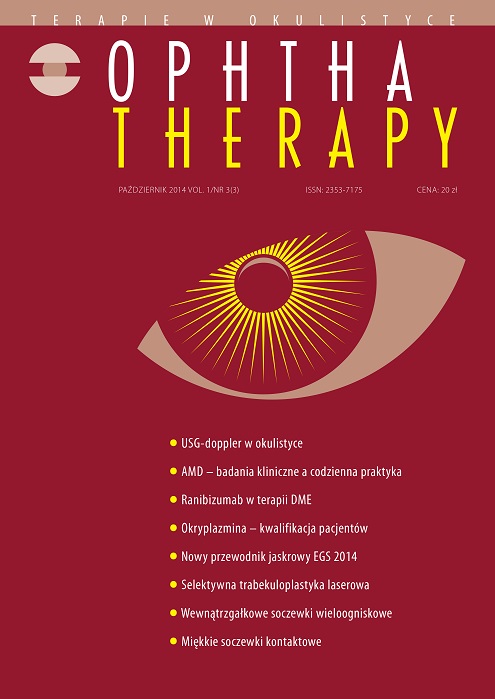Appropriate patient estimation – clinical features improving success ratio for ocriplasmin treatment regarding Vitreomacular Interface Classification
Main Article Content
Abstract
Approval of ocriplasmin for the treatment of symptomatic vitreomacular adhesion widened therapeutic options. New classification of VMI based on OCT allows to precisely enroll patient for ocriplasmin treatment. Indications for treatment include: symptomatic VMA, often connected with VMT and MH. Based on multicentered clinical trial best outcome is expected in cases with VMA < 1500 μm and MH < 250 μm.
Downloads
Article Details

This work is licensed under a Creative Commons Attribution-NonCommercial-NoDerivatives 4.0 International License.
Copyright: © Medical Education sp. z o.o. License allowing third parties to copy and redistribute the material in any medium or format and to remix, transform, and build upon the material, provided the original work is properly cited and states its license.
Address reprint requests to: Medical Education, Marcin Kuźma (marcin.kuzma@mededu.pl)
References
2. Stalmans P., Benz M. Enzymatic vitreolysis with ocriplasmin for vitreomacular traction and macular holes. N Engl J Med. 2012; 367(7): 606-15.
3. Haller JA, Stalmans P. Efficacy of Intravitreal Ocriplasmin for Treatment of Vitreomacular Adhesion: Subgroup Analyses from Two Randomized Trials. Ophthalmology. 2014 Sep 17; pii: S0161-6420(14)00689-7. https://doi.org/doi: 10.1016/j.ophtha.2014.07.045.
4. John VJ, Flynn HW Jr. Clinical course of vitreomacular adhesion managed by initial observation. Retina. 2014; 34(3): 442-6.
5. Bottós JM, Elizalde J, Rodrigues EB et al. Current concepts in vitreomacular traction syndrome Curr Opin Ophthalmol. 2012; 23(3): 195-201.
6. Ezra E. Idiopathic full thickness macular hole: natural history and pathogenesis. Br J Ophthalmol. 2001; 85(1): 102-8.
7. Stefanini FR, Maia M, Falabella P et al. Profile of ocriplasmin and its potential in the treatment of vitreomacular adhesion. Clin Ophthalmol. 2014; 8: 847-56.
8. Schneider EW, Johnson MW. Emerging nonsurgical methods for the treatment of vitreomacular adhesion: a review. Clin Ophthalmol. 2011; 5: 1151-65.
9. Wong SC, Capone A Jr. Microplasmin (ocriplasmin) in pediatric vitreoretinal surgery: update and review. Retina. 2013; 33(2): 339-48.
10. Duker JS, Kaiser PK, Binder S et al. The International Vitreomacular Traction Study Group classification of vitreomacular adhesion, traction, and macular hole. Ophthalmology. 2013; 120(12): 2611-9.

